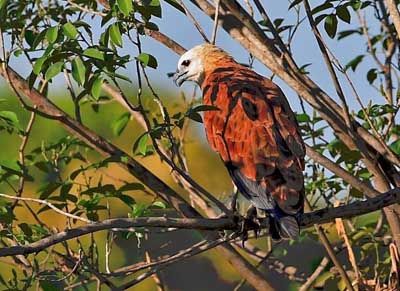
Black-collared Hawk
Busarellus nigricollis
Accipitriforme Order – Accipitridae Family
BIOMETRICS :
Length: 46-51 cm
Wingspan: 114- 134 cm
Weight: M : 695 g – F : 795 g
DESCRIPTION:
Black-collared Hawk has broad, rounded wings and short, squared tail.
Fr : Buse à tête blanche
All : Fischbussard
Esp: Busardo Colorado
Ital: Poiana dal collare nero
Nd: Moerasbuizerd
Russe: Канюк-рыболов
Photographers:
Marc Chrétien
MURINUS
Maxime Dechelle
LEPAPARRAZO
Patrick Ingremeau
TAMANDUA
Text by Nicole Bouglouan
Sources:
HANDBOOK OF THE BIRDS OF THE WORLD Vol 2 by Josep del Hoyo-Andrew Elliot-Jordi Sargatal - Lynx Edicions - ISBN: 8487334156
A GUIDE TO THE BIRDS OF MEXICO AND NORTHERN CENTRAL AMERICA by Steve N. G. Howell, Sophie Webb - Oxford University Press - ISBN: 0198540124
A GUIDE TO THE BIRDS OF COLOMBIA by Steven L. Hilty and William L. Brown - Princeton University Press – ISBN 069108372X
PORTRAITS D’OISEAUX GUYANAIS - Groupe d'étude et de protection des oiseaux en Guyane (GEPOG) - Ibis rouge éditions - ISBN: 2844501842
Adult has chestnut-cinnamon plumage overall, but we can see black shaft streaks on the back. On the wings, the primary flight feathers are black. The tail is black too, with indistinct rufous bars.
On the underparts, we can see a black crescent on the upper breast.
Head and neck are whitish to buffy-white, with fine brownish streaks on the crown.
The hooked bill is black. Eyes are dark brown. Legs and feet are pale flesh to greyish-white.

Both sexes are similar, with female larger than male.
Immature is browner and darker than adults. Upperparts are spotted and barred rufous. Breast is paler, streaked darker. Belly is finely barred fuscous. Head is paler than body.
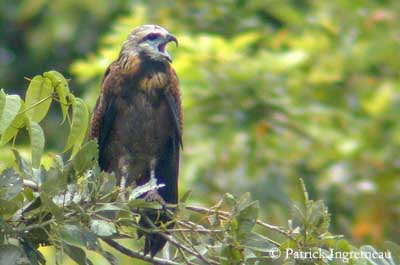
We find two subspecies: B.n. nigricollis and B.n. leucocephalus. This one is larger, with whiter head.
VOICE: SOUNDS BY XENO-CANTO
Black-collared Hawk juvenile utters long mewing calls from perch “wheeeeah”, and short cheeping.
Adults utter long guttural croaks, also short, hoarse, raspy “eh-rrrr”, and screaming whistles “hieeee”.
This species is usually silent outside the breeding season.
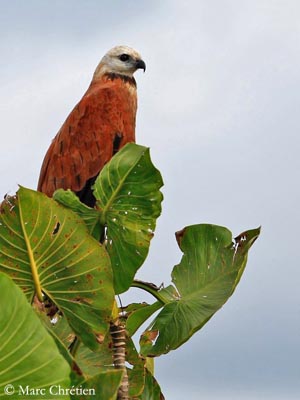
HABITAT:
Black-collared Hawk frequents tropical zones with fresh or brackish water. It can be seen along large rivers, as well in open areas as in dense moist forest, swamps, lakes with floating vegetation and swampy lagoons. It occurs at up to 500 metres of elevation in Colombia.
RANGE:
Black-collared Hawk is found in Mexico, through Central America to South America, mainly in the north-eastern parts of the continent. It is absent of the west coasts and southern Argentina.
BEHAVIOUR:
Black-collared Hawk feeds mainly on fish. It hunts from low perch near water. When the prey is detected, it swoops down and catches the fish with the talons. It drops the feet first into the floating vegetation or into shallow water close to the shore.
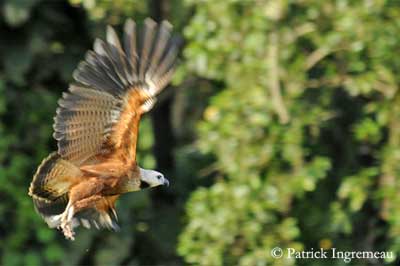
This raptor has very peculiar feet, covered with quills, making easier to capture the slippery fishes.
This species also consumes snails and aquatic insects, and occasionally some lizards and rodents.
Black-collared Hawk is sedentary in its range. It may move according to the water levels.
FLIGHT:
Black-collared Hawk often soars with the wings slightly arched and the hands slightly raised.
This raptor is often seen flying low over swampy areas. It performs deep and powerful wing beats. It also glides with bowed wings and raised tips. The tail is usually closed.
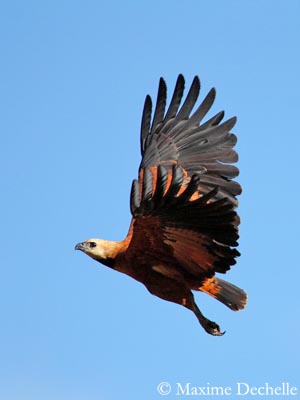
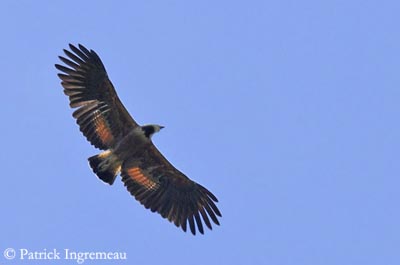
REPRODUCTION:
Breeding season varies according to the range.
Black-collared Hawk builds a nest in tall trees or in mangroves. The nest is a bulky platform made with sticks. The interior is lined with green leaves. It is usually situated near water, at about 12-15 metres above the ground.
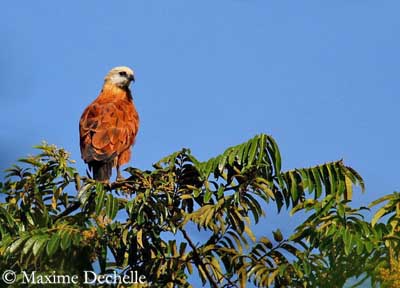
Female lays one single greyish-white egg spotted brown and darker grey.
The nesting behaviour of this species is poorly known, but from observations and photographs taken in Suriname, the young is fed by the adults which bring the fish at nest.
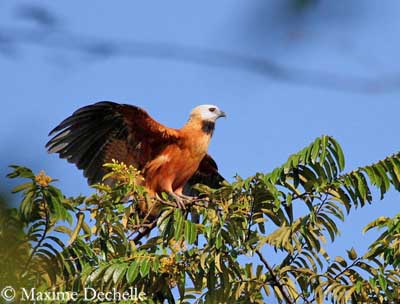
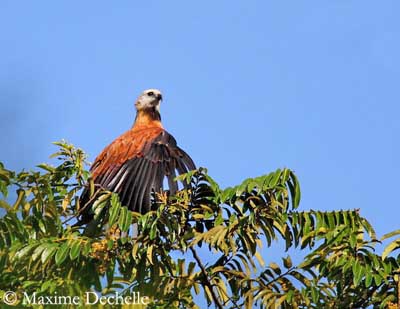
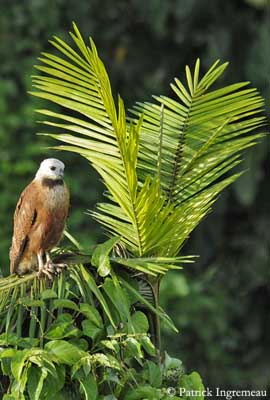
DIET:
Black-collared Hawk feeds mainly on fish, caught with the talons at the fishing-eagles do.
It also takes aquatic insects and bugs, snails, lizards and rodents.
PROTECTION/THREATS/STATUS:
Black-collared Hawk is common in suitable habitat in most parts of the wide range.
Some declines occur, due to drainage of wetlands in Panama.
However, this species is not threatened at this moment.